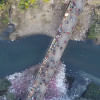If a dam must be built, it must be built right

There are certain conditions facing our rivers for which one can only blame nature, such as river erosion and flooding, even though these can also be attributed to human-induced climate change now. But our rivers and canals—and the communities surrounding them—also face issues that derive purely from lack of foresight. One such issue is the ill-planned construction of dams. As per a report by this daily, the Water Development Board recently dredged a 23km stretch of the Bishkhali River in Bagerhat's Kachua upazila.
For this, the contractor also built several dams, thereby stopping the flow of water to different canals connecting 18 villages in Badhal union. So now, while the project originally aimed to benefit farmers by enhancing the flow of freshwater in the river, it is doing exactly the opposite as multiple Boro paddy fields, canals, irrigation channels, and fish enclosures have dried up. We have seen the failure of numerous such dams and dikes over the years.
For example, just the other day, we wrote of how the construction of a three-vent regulator on the Korotoa River in 1996 causes it to remain dry for most of the year, obstructing fish migration and causing pollution and water stagnation. What the river authorities fail to grasp is that solutions such as embankments, if not properly planned, can cause more problems than benefits. This is partly because they do not engage with the local communities before implementing a project. As such, while the problem they are initially targeting may be eliminated, the subtle or long-term side effects of a project remain unknown until after completion. This explains why embankments meant to reduce flow of saline water to canals, such as on Daratana River, are also restricting overall waterflow.
It is crucial for public project managers, especially those working with natural resources on which people's livelihoods are dependent, to be careful and farsighted in their planning. They must engage with local communities and experts to work out effective plans before undertaking a project.


 For all latest news, follow The Daily Star's Google News channel.
For all latest news, follow The Daily Star's Google News channel. 










Comments